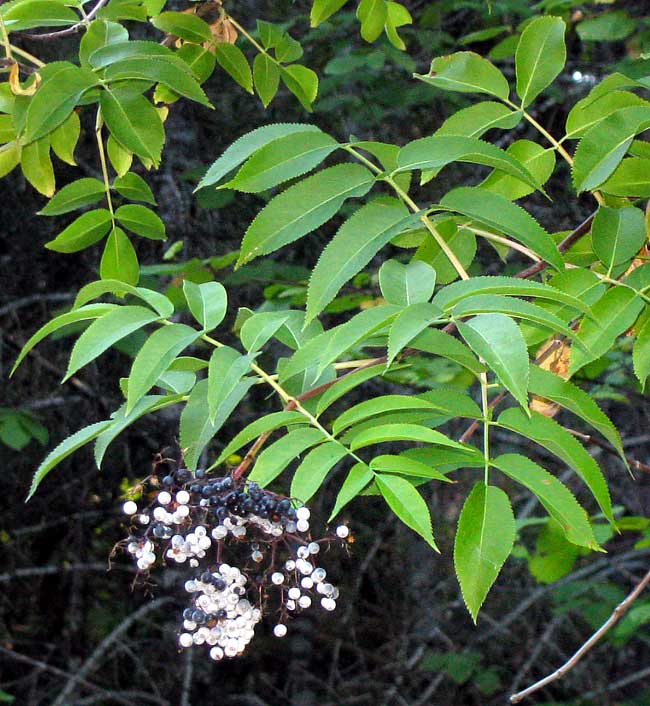Excerpts from Jim Conrad's
Naturalist Newsletter

from the the September 27, 2009 Newsletter, issued from the Siskiyou Mountains west of Grants Pass, Oregon:
BLUE ELDERBERRIES
A couple of weeks ago Andy, a college senior in California majoring in ecology, dropped by for a talk. He was gracious enough to arrive with a gift -- a fruiting inflorescence of the local elderberry. He'd collected it lower in elevation; our elderberries weren't fruiting yet.
At first the gift struck me as a bit curious because the blackish fruits of the Eastern Elderberry I'm most familiar with are gorgeously succulent and in sunshine glow with a pretty, bluish tint, but they don't taste good. Of course that's a different species so I plopped some of Andy's fruits into my mouth, and they were excellent! During this week's valley hike our elderberries had ripened and I ate a lot. A roadside elderberry bush's opposite, pinnately compound leaves and hand-size, flat-topped fruit cluster is shown above.
Some fruits in the picture appear whitish while others are blackish with a blue tint. In fact, all the fruits are blackish with a blue tint, just that the white ones haven't had their silvery bloom, or glaucescence, rubbed off. Maybe a bird while feeding fluttered a wing against the darker ones. Fruits are seen closer below:

This is the Blue Elderberry. Currently elderberry taxonomy is in such a mess that you find the species going by several technical names. California's Jepson Manual calls it SAMBUCUS MEXICANA but the USDA lists it as Sambucus nigra ssp. cerulea, and Wikipedia's expert claims that it's Sambucus cerulea. This is one of those rare instances when the common name may be more useful than its technical one.
Whatever its technical name, it's a wonderful plant. Birds and other animals love eating its fruits. Its soft-woody stems and leaves provide high-quality browse for deer, chipmunks, rabbits, squirrels, mice, rats and livestock. In fact, livestock relish its vegetative parts so that wherever Western ranchers graze livestock, including vast acreages of public land such as Bureau of Land Management holdings, Blue Elderberry has been totally extirpated.
In the first picture, did you notice that even at this late season the plant's leaves look in good shape? Compared to other species they are relatively disease free and even without evidence of bug gnawings. One reason is that elderberries appear to have a natural resistance to many diseases and insects. This suggests potential medicinal value for humans, and it's true that Native Americans used Blue Elderberry plants when treating sore or swollen limbs, headaches, swelling, relief from pain in general and when they needed an antiseptic wash.
Native Americans also called Blue Elderberries "tree of music" because they made flutes from the shrub's branches cut in the spring and dried with the leaves on.